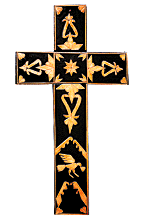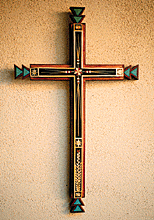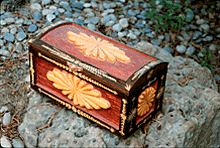A Tradition of Making Straw
into Gold
|
 |
During the 1700s in many of the northern
New Mexico villages, gold was a precious commodity and its use
on crosses for worship was impractical. The gold had to be transported
up El Camino Real from Mexico and its use was strictly supervised.
The necessity to have crosses and other decorated items that
had the look of gold caused the early Hispanics to "invent" a
process that adhered straw, corn and wheat to wood. One technique
was straw inlay or appliqué and another was encrusted
straw.
|
|
Many artists started with painted wood to achieve
a dark or colored solid background. Lamp black and indigo were
used to color most of the crosses. Thin, dried strips and pieces
of golden straw and corn husks were applied to the painted surface
with a natural glue. In the encrusted straw process, some artists
used a heavy natural lacquer to coat the surface after the design
was completed. The result was a thick and glossy surface on the
crosses.
Because the ornamentation of crosses, frames
and furniture with straw was relatively fragile, not many of
these historic pieces remain today. Nonetheless, some examples
do exist in the permanent collection of the Museum of International
Folk Art in Santa Fe, the Taylor Museum of the Colorado Springs
Fine Arts Center and in some private collections. From the few
pieces available for study, today's artists have revitalized
the artform and have even taken it a step beyond its historic
boundaries.
Contemporary masters of straw are Paula
and Eliseo Rodríguez of Santa Fe. Now in their 80s, they have
won major awards for their intricately-designed crosses and retablos
that portray the stations of the cross, the passion of Christ,
geometrics or scenes from nature.
|

Image: © Jimmy Trujillo
Encrusted Straw Cross
|

Image: © Charlie Sanchez
Straw Appliqué Cross
|
Paula and Eliseo rediscovered the art of straw
in the late 1930s as part of the Federal Art Project. They continued
to refine and experiment with techniques and entered Spanish
Market in the early 1970s as the first straw artists in the Market.
In 1989 they received the Award for Lifetime Achievement from
the Spanish
Colonial Arts Society  Paula
and Eliseo have passed down the tradition to their daughters,
Vickie and Yolanda, as well as to four of their eleven grandchildren,
Jessica, Monica, Gabriel and Marcial, all of whom exhibit annually
in Spanish Market in Santa Fe. Paula
and Eliseo have passed down the tradition to their daughters,
Vickie and Yolanda, as well as to four of their eleven grandchildren,
Jessica, Monica, Gabriel and Marcial, all of whom exhibit annually
in Spanish Market in Santa Fe.
Jimmy Trujillo and his family are crusaders
for the encrusted straw artform. Jimmy researched the technique
for many years and though it is more difficult than straw inlay
and requires more time to dry and cure, he believes it to be
the true historic way to work. Jimmy, his wife Debbie and daughter
Cordelia, age 12, have won awards at Spanish Market, State Fair
and have pieces of their work in many permanent collections including
the American Museum of Straw Art in Long Beach, California.
|
|
Charlie Sánchez, Jr of Tomé,
NM taught his daughter Vanessa how to do his interpretation of
straw inlay and her work generally sells out in the first few
hours of Spanish Market. Charlie's style is different in that
he uses natural pigments to color his crosses in interesting
new shades of blue, brown, green and red.
The pigments are found in local minerals and
plants that he grinds up and mixes into a paint that is applied
before the straw. Charlie has won awards at Spanish Market and
the New Mexico State Fair for his work.
Krissa López of
Española is a gifted young artist who fits in her straw
appliqué work with her love of pottery, painting and printmaking. |

Image: © Charlie Sanchez
Straw and wood appliqué box
|
|
She has won awards at Spanish Market for her
straw designs but finds enjoyment in trying contemporary art
forms. Her father, Félix López, an award-winning
santero, uses straw appliqué decoration on some of his
santos.
In 1997 fourteen adults and six youth artists
were juried into Spanish Market who are using straw as their
art medium. This is probably the largest number of practicing
straw artists in the history of New Mexico. Some of the new and
collectible straw artists to watch are: Felipe Griego, Mel Rivera,
Lorrie Aguilar-Sjoberg, Diane Moya Lújan. Many of the
artists give classes during the year to share the techniques
and traditions.
Collectors interested in learning more about
the traditional art of straw in New Mexico can meet the artists
at Spanish
Market  in
Santa Fe, the last full weekend of July, or at Winter Market
in Santa Fe, the first full weekend of December.
The New Mexico State Fair in Albuquerque also has a straw category
for judging. in
Santa Fe, the last full weekend of July, or at Winter Market
in Santa Fe, the first full weekend of December.
The New Mexico State Fair in Albuquerque also has a straw category
for judging.
Read another article about Straw Art in New Mexico  by Claude Stephenson. by Claude Stephenson. |
Thanks to Barbe Awalt and Paul Rhetts, Authors
of Charlie Carrillo: Tradition & Soul and Our
Saints Among Us: 400 Years of Devotional Art. On the Web
at www.nmsantos.com 
Originally appeared in
The Collector’s Guide to Santa Fe and Taos - Volume
12
|
|
